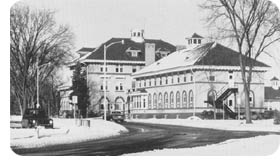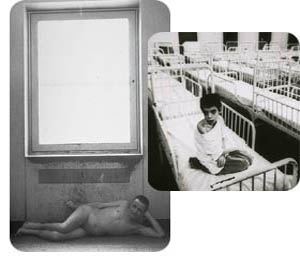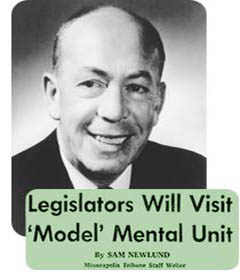1960s: Building the Momentum
Bigger Facilities
The prevailing wisdom continued to hold that bigger facilities meant lower costs.
In 1961, more than 6,565 residents with developmental disabilities – an all-time high – lived in state hospitals. In addition, almost 900 people waited for care.
At the urging of Governor Elmer L. Andersen, the Legislature authorized $36,000 to develop a pilot project to create day activity centers designed expressly to help individuals reach their optimum capabilities.
The first pilot programs opened in February 1961 at Willmar and Litchfield.

Pilot programs in Willmar and Litchfield taught life skills to people with developmental disabilities.
Institutional Reform Continues
Throughout the 1960s, institutional reform continued on a wide scale. Willmar became the first "open" hospital, both physically (through open doors) and psychologically (through minimal use of restraints).
Professional administrators were hired to manage the business end of the hospital, leaving the practice of medicine to psychiatrists and other medical experts.
Minnesota continued to lead the nation in redefining the care of people with developmental disabilities.

The state hospital at Willmar was the first to become an "open" hospital.
In January 1962, the state conducted the nation's first survey of state hospitals. Survey results revealed that 475 of Minnesota's 6,565 state hospital residents could be released if community placements were available. It also showed that 14 percent of the residents had IQs over 60.
Under Dr Vail's direction, "dehumanization" practices in state hospitals were attacked intensely in 1963. Surveys of wards were conducted and problem identification/solving approaches were implemented to reduce dehumanization.

Dehumanizing individuals means treating them as less than human.
Video: Miriam Karlins, former official of the Department of Public Welfare, worked with medical director, David Vail, to eliminate dehumanizing practices in state institutions.
Part 2: Dehumanization Occurs in All Types of Settings
Part 3: Changes Brought on by the Ward Living Conditions Survey

An award-winning documentary raised awareness of the way people are dehumanized in institutional settings.
A documentary film, Dehumanization and the Total Institution, starring an Inspector Clouseau-like undercover agent, won several national awards.
This documentary described how people were treated in military service, in prisons and in state hospitals. The film reminded the audience that levels of care were often based on the convenience of staff, rather than for the actual benefit of the resident.
1962 Public Opinion Poll
In 1962, the state Arc and Department of Public Welfare jointly sponsored a public opinion poll of hundreds of Minnesotans.
While most of those surveyed could define mental retardation, most didn't know its causes or the kind of employee or neighbor such a person might make. However, the majority believed such folks should live normal lives, as long as they didn't vote or drink.
In 1963, federal funds became available through the Mental Retardation Facilities Construction Act to build community facilities. Minnesota was the first state to submit a plan to the U.S. Surgeon General, capturing $3.8 million in grants.
Although the State of Minnesota is fairly small in population compared to other states, the plan weighed almost 6 pounds and was approved in April 1966.

A 1962 public opinion survey indicated that the majority of respondents believed people with developmental disabilities should be allowed to lead normal lives.

Governor Rolvaag:
Took the Show on the Road
In 1963, Governor Karl Rolvaag led four bus tours for state officials, legislators, parents and advocates to visit state hospital programs, focus on the patients, share ideas and communicate.
Governor Rolvaag used the bus tours to build rapport with state legislators, to build support for the changes and to establish local support in communities around the state.







